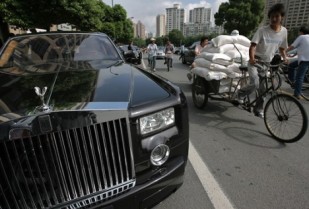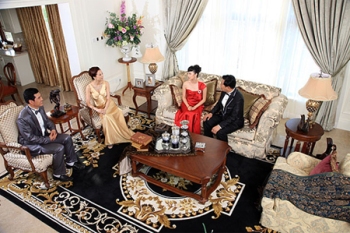According to a recent survey, Chinese high net worth individuals (HNWIs) – defined as people with US$1.5 million or more in investible assets – more than 50 percent are either planning to, or are considering, emigrating from China.
According to Bain Consulting and China Merchants Bank, there are around 1.6 million Chinese with investible assets of $1.5 million or more, up from 180,000 in 2006. (Note: Ask anyone who’s familiar with China and they’ll likely tell you the real figure is far higher than that.)
around 1.6 million Chinese with investible assets of $1.5 million or more, up from 180,000 in 2006. (Note: Ask anyone who’s familiar with China and they’ll likely tell you the real figure is far higher than that.)
For Chinese people looking to leave China, the U.S. and Canada are the most popular destinations, followed by the U.K. and Australia.
Cities on the west coast of the U.S. are the preferred emigration destinations for the Chinese. These cities are of course closest to China, increasingly served with regular direct flights and have substantial existing Chinese communities.
If half of U.S. millionaires were looking at leaving the country, clearly we’d want to know why. Education and environment are the primary factors motivating rich Chinese people to leave China.
Chinese political and military elites have long spurned local higher education, instead sending their offspring to study at prestigious western universities for a better education than what’s available at home. The daughter of Chinese President Xi Jinping, for example, studied at Harvard University in the U.S. For reference, in the Times Higher Education 2017 World University Rankings, the first Chinese university is ranked 29th.
Clean air and water, safe food and an open-minded education are attractive to anyone – and especially wealthy Chinese.
In addition, some 84 percent of participants cited the depreciation of the Chinese yuan as a key concern and driver for looking to move and buy real estate abroad.
But there are other reasons that push the wealthy to look overseas. The reality is in China, if you cross the authorities, everything can get pretty bad for you, and quickly. You’ll notice that the top 10 cities listed in the table above are all found in countries with open and transparent rule of law – which is lacking in China.
An overseas exit plan provides an insurance policy, should a swift departure ever need to be made.
According to Pierre Gervois, Founder of the Shanghai Travelers’ Club, an international travel club for Chinese elites, and Publisher of the STC magazine, “Contrary to what Europeans and American analysts think, HNWI Chinese are perfectly aware of China’s economic situation. The myth of a growing and successful China has been carefully entertained by the Chinese government in order to maximize Foreign Direct Investments (FDA’s), but the Chinese elite had never been naive. They know for fifteen year that this growth is not sustainable and it might be time to leave the boat for them and their close family.”
Property prices on the west coast of the U.S. have been boosted, in part, by continued buying by people from China. There have been numerous reports over the years of open houses being completely dominated by Chinese-speaking viewers, and even tour groups focusing on acquiring real estate.
And Chinese students will continue to flock to the U.S., with some 60 percent of all overseas students in the U.S. now hailing from China. Again, Mum and Dad will often buy real estate, along with a degree for junior.
What’s the easiest way for a wealthy Chinese individual to get a green card? Well, as the sister of U.S. President Trump’s son-in-law and special advisor, Jared Kushner, told an audience of Chinese investors in May in Beijing, you just need to invest in a bit of Kushner family real estate development.
The EB-5 visa programme allows for overseas investors to put US$500,000 in projects that create at least 10 jobs (in areas of high unemployment), or a million dollars in other areas, and in return apply for permanent residency in the U.S.
Jared Kushner, prior to his White House role, raised US$50 million from Chinese EB-5 investors for a Trump-branded apartment complex in Jersey City, New Jersey.
Not surprisingly, this has been hugely popular with wealthy Chinese. Around 85 percent of the visas have gone to Chinese, and there is a backlog of more than 20,000 applications.
Although the EB-5 program is likely to be altered or at least reviewed, the U.S. looks set to remain a popular destination for Chinese money for the foreseeable future.
Source: Stansburry Churchouse Research / Business Insider Blog / Tama Churchouse / Chinese Tourists in America Blog
 Citcon, the integrated payment and marketing platform, announced a strategic partnership to enable brands in North America to accept
Citcon, the integrated payment and marketing platform, announced a strategic partnership to enable brands in North America to accept  China’s outbound luxury travelers spend $65,000 per household on tourism per year, including $34,000 on travel shopping, according to a new study from
China’s outbound luxury travelers spend $65,000 per household on tourism per year, including $34,000 on travel shopping, according to a new study from 

 A hundred years ago, Amadeo Modigliani painted a portrait of his wild British mistress splayed across a red velvet throw, nude, her hips arched, her kohl-rimmed eyes shut. The artist was hardly trying to play it safe – Paris officials promptly shut down the show where the work was first exhibited.
A hundred years ago, Amadeo Modigliani painted a portrait of his wild British mistress splayed across a red velvet throw, nude, her hips arched, her kohl-rimmed eyes shut. The artist was hardly trying to play it safe – Paris officials promptly shut down the show where the work was first exhibited.
 The Shanghai Travelers’ Club, a
The Shanghai Travelers’ Club, a 


 Another study from China Elite Focus, the publishing company of the Shanghai Travelers’ Club magazine, a luxury lifestyle publication for Chinese billionaires, showed that 72% of Chinese with a personal wealth over $50 million will consider to purchase a property overseas in 2014.
Another study from China Elite Focus, the publishing company of the Shanghai Travelers’ Club magazine, a luxury lifestyle publication for Chinese billionaires, showed that 72% of Chinese with a personal wealth over $50 million will consider to purchase a property overseas in 2014. Still, much of China’s offshore wealth is moved illegally or in the shadow economy. China maintains a closed capital account and Chinese citizens are generally not permitted to move more than $50,000 out of the country. So reliable data on exactly how much money is moving out remains unclear.
Still, much of China’s offshore wealth is moved illegally or in the shadow economy. China maintains a closed capital account and Chinese citizens are generally not permitted to move more than $50,000 out of the country. So reliable data on exactly how much money is moving out remains unclear.
